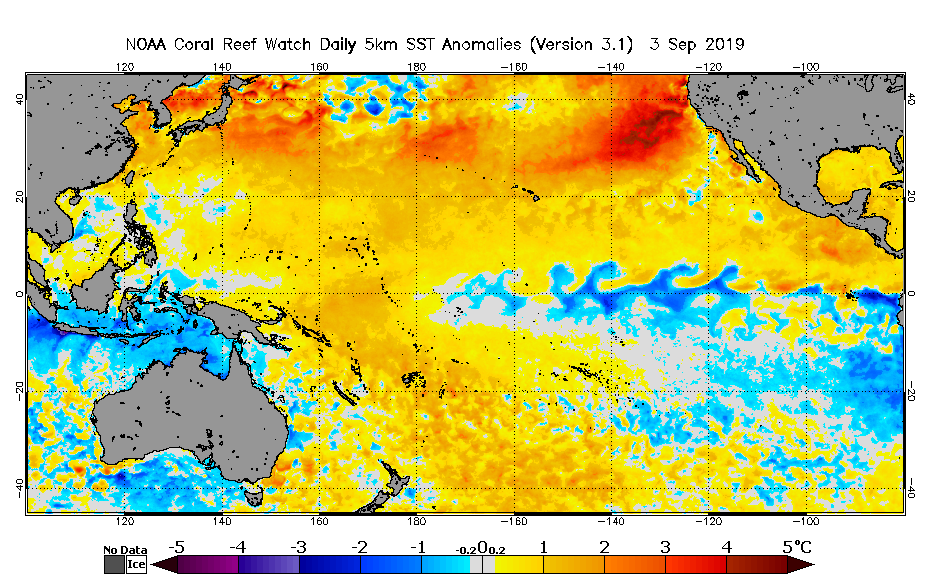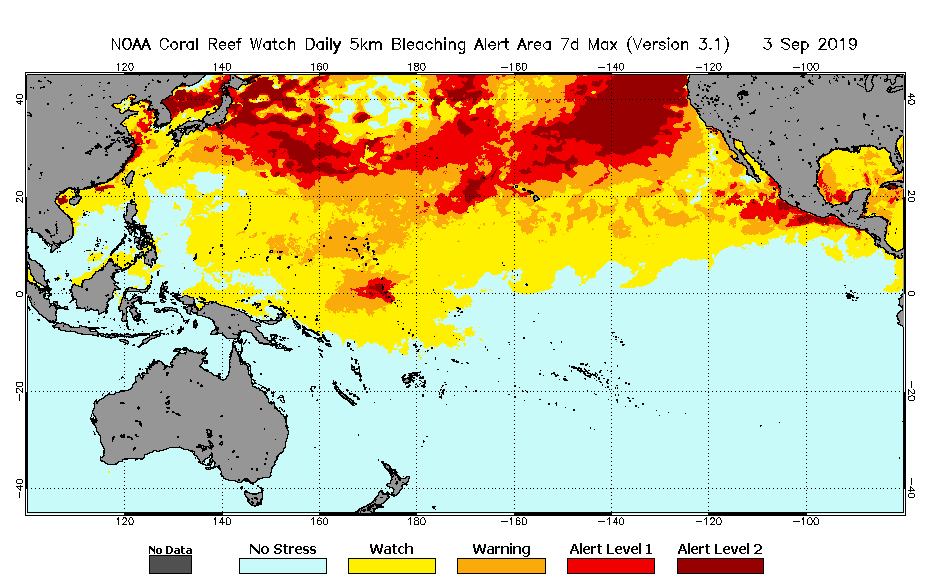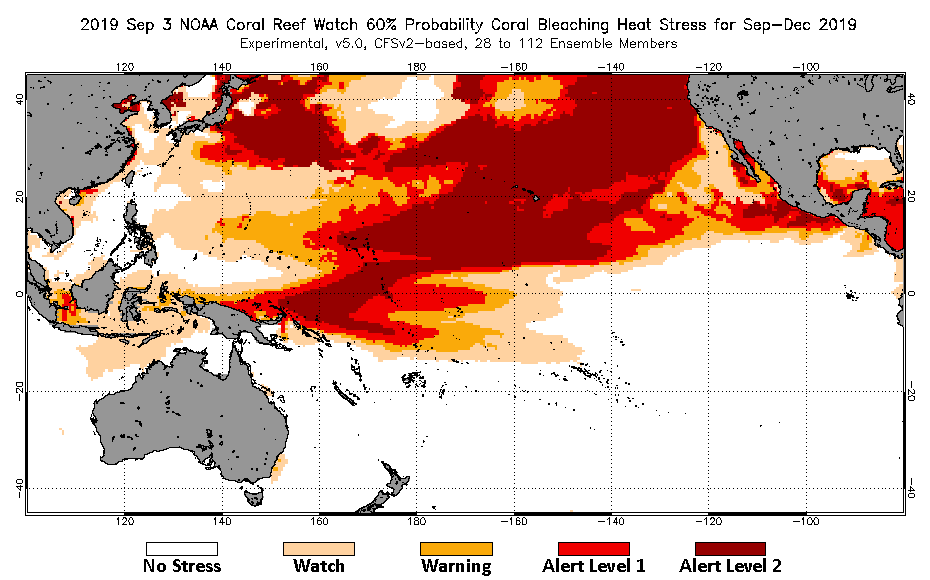Coral Bleaching Heat Stress Analysis and
Seasonal Guidance through December 2019
(Released September 3, 2019)
Current conditions:
NOAA Coral Reef Watch's (CRW) near real-time satellite monitoring shows the sea surface temperature (SST) as alternating below- and above-average along the equator in the eastern and central equatorial Pacific; as being below-average in the southeast Pacific; and as being above-average throughout the rest of the ocean basin (Figure 1). The system seems to be progressing toward El Niño Southern Oscillation (ENSO)-neutral conditions. Additionally, over recent months, warm anomalies (>2°C) have surrounded the Northwestern Hawaiian Islands (NWHI) and Main Hawaiian Islands (MHI), and a mass of anomalously warm water (3-4°C above average) has developed off the west coast of the United States. As of August 8, 2019, the NOAA National Centers for Environmental Prediction's ENSO Alert System issued its last El Niño Advisory for the season. ENSO-neutral conditions are expected to continue through Northern Hemisphere winter 2019-2020 (50-55% chance).

|
||
|
Figure 1. NOAA Coral Reef Watch's Satellite Sea Surface Temperature Anomaly product for the Pacific region. |
||
Some HotSpots remain around the Marshall Islands, Nauru, and the Gilbert Islands, Kiribati. The regions with the highest HotSpot values, which are accumulating to conditions conducive to mass coral bleaching, are now between 20°N and 40°N in the North Pacific Ocean, affecting the entire Hawaiian Archipelago, Johnston and Wake Atolls, and the Ogasawara Islands (Figure 2). The current bleaching status for the MHI and Johnston Atoll is Alert Level 1, and the NWHI is at Alert Level 2. Further south, Wake Atoll, the Ogasawara Islands, the Marshall Islands, and Nauru are at Bleaching Warning status (Figure 3). Earlier this year, in May-July, the Gilbert Islands had some relief, but soon reached Alert Level 2 again in August 2019. In the Hawaiian archipelago, as of late August 2019, bleaching had been reported at Lisianski Island and at French Frigate Shoals (NWHI), at Kealakekua Bay on Hawaii, and at Kaneohe Bay and Hanauma Bay on Oahu. Temperatures throughout the Hawaiian archipelago are expected to keep rising through October. NOAA issued an advisory to the State of Hawaii warning of another potentially catastrophic bleaching event similar to that in 2014 and 2015. In response, the Hawaii Department of Land and Natural Resources issued a news release asking for the public's help. In an unprecedented era of global warming, the public is being asked to reduce local stressors by keeping themselves, contaminants like chemical sunscreens, and boats and anchors off reefs, and by limiting fishing of critical herbivores that control algal blooms during bleaching events. There also is a call for the public and citizen science monitoring networks to document coral bleaching or death they observe on local reefs.

|
||
|
Figure 2. NOAA Coral Reef Watch's Satellite Coral Bleaching HotSpot product for the Pacific region. |
||

|
||
|
Figure 3. NOAA Coral Reef Watch's Satellite Bleaching Alert Area (7-day maximum) product for the Pacific region. |
||
CRW's most recent Four-Month Coral Bleaching Outlook (Figure 4) projects high heat stress (up to Alert Level 2) in the central and western Pacific Ocean, around the Hawaiian archipelago, in September and October. As of November and December, the high heat stress is expected to migrate to the southwest, potentially affecting the central and western equatorial Pacific Islands, from the Northern Line Islands westward to the Solomon Islands and Papua New Guinea (Alert Levels 1 and 2).

|
||
|
Figure 4. NOAA Coral Reef Watch's Four-Month Coral Bleaching Heat Stress Outlook of September 3, 2019 for the period September-December 2019 for the Pacific region. |
||
***NOTE: This report incorporates NOAA Coral Reef Watch's Version 3.1 (or v3.1) daily global 5km satellite-based coral bleaching heat stress products and v5 Four-Month Coral Bleaching Heat Stress Outlook.***
To monitor the intensity and location of bleaching heat stress in your coral reef region of interest, please follow NOAA Coral Reef Watch's satellite monitoring and outlooks closely in the coming weeks: https://coralreefwatch.noaa.gov/product/5km/index.php and https://coralreefwatch.noaa.gov/satellite/bleachingoutlook_cfs/outlook_cfs.php.
CRW's current satellite and modeled products can be found at:
https://coralreefwatch.noaa.gov/satellite/index.php
CRW's Four-Month Coral Bleaching Heat Stress Outlooks can be found at:
https://coralreefwatch.noaa.gov/satellite/bleachingoutlook_cfs/outlook_cfs.php
CRW's 5km satellite Regional Virtual Stations can be found at:
https://coralreefwatch.noaa.gov/vs/index.php
Sign up for automated bleaching alert emails for CRW's 5km Regional Virtual Stations at:
https://coralreefwatch.noaa.gov/subscriptions/vs.php
Please report bleaching events (or non-events) at:
https://coralreefwatch.noaa.gov/satellite/research/coral_bleaching_report.php
Disclaimer
The content posted on this web page solely represents the opinions of the authors and does not constitute a statement of policy, decision, or position on behalf of NOAA or the US Government.
The appearance of external links on this World Wide Web site does not constitute endorsement by the Department of Commerce/National Oceanic and Atmospheric Administration of external Web sites or the information, products or services contained therein. For other than authorized activities, the Department of Commerce/NOAA does not exercise any editorial control over the information you may find at these locations. These links are provided consistent with the stated purpose of this Department of Commerce/NOAA Web site.